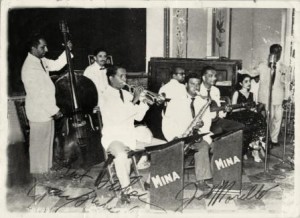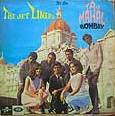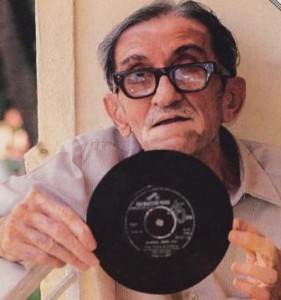In 2004, the Sri Lankan pop sensations from the 1960s, The Jet Liners, held a reunion concert in Colombo. As a finale, they performed this song: Bombay Meri Hai – a tune that has been a Bombay party standard since was released four decades ago. The first time I realised that the tune was hugely popular south of the Palk Straits was in 2000, while eating a meal in a Sri Lankan restaurant in the New York borough of Staten Island. As I tucked into my hoppers and curry, a Sinhalese version of Bombay Meri Hai called Ran Ran Ran blasted out of the speakers. I marvelled at how a song composed by a guy who lived around the corner from me in Bombay had spread around the globe like this.

Bombay Meri Hai is among my earliest musical memories. When I was a child, the song was always being played on Saturday Date, the pop music request show on All India Radio. But mostly, I heard the tune being performed week after week by wedding bands at the Bandra Gymkhana, opposite my grandparents’ home. Bombay Meri Hai is among the songs in the “masala” section of Catholic wedding parties – the fast-paced crescendo during which revellers wave white handkerchiefs above their heads to conjure up a long-forgotten aboriginal past as they dance to Marathi and Konkani folk tunes.
Perhaps because it’s invariably performed alongside tunes like Galyan Sakli Sonyachi and Sonyachi Kavla, I’d always thought of Bombay Meri Hai as a traditional Bombay Catholic tune. So I was more than a little intrigued when, deep into the graveyard shift at The Times of India in 1991, my Parsi colleague Roxanne Kavarana told me that not only did she know the man who had composed the tune, she was actually related to him. Over the next few years, I’d come to learn a little more about how Mina Kava came to compose the first-ever Indo-pop hit.
 This photo was taken in 1958, when Mina Kava – peering out from behind the drums – was still a few years away from his burst of success (or at least success as defined by the standards of the tiny world of Indian dance music). It was shot at the Bandra Gymkhana when his band, the Music Makers, was staffed with best-known performers of the Bombay jazz world: pianist Toni Pinto, trumpet player Chic Chocolate and saxophonist Norman Mobsby. If you look closely, you’ll see that the photo was signed at the bottom by two visiting American musicians: Dave Brubeck and Joe Morello. (Not pictured here are six men who were vital to the smooth functioning of the Music Makers and indeed, most Bombay dance bands of the time – well-muscled coolies. “Sure, we had to transport the piano from venue to venue,” Kava explained.)
This photo was taken in 1958, when Mina Kava – peering out from behind the drums – was still a few years away from his burst of success (or at least success as defined by the standards of the tiny world of Indian dance music). It was shot at the Bandra Gymkhana when his band, the Music Makers, was staffed with best-known performers of the Bombay jazz world: pianist Toni Pinto, trumpet player Chic Chocolate and saxophonist Norman Mobsby. If you look closely, you’ll see that the photo was signed at the bottom by two visiting American musicians: Dave Brubeck and Joe Morello. (Not pictured here are six men who were vital to the smooth functioning of the Music Makers and indeed, most Bombay dance bands of the time – well-muscled coolies. “Sure, we had to transport the piano from venue to venue,” Kava explained.)
Kava gave his first performance playing the harmonica on AIR’s Children’s Hour. After a stint as the leader of Phiroze Damri’s Hohner Harmonica Band, he began to take piano lessons so that he could start working on his own compositions. He rounded out his musical education with drumming lessons from Karl Lord, who lived around the corner from him, near Almeida Park in Bandra, and Hindustani vocal training with Pandit P Madhukar. After doing two bachelor’s degrees (he got a BA from St Xavier’s College and a BCom from Sydenham), Kava started playing percussion instruments for Hindi film soundtracks. But he gave up when he decided that the film industry was “run by cliques”.
In 1969, the recording company HMV asked Kava and the Music Makers to write a song about the city in which he lived. Kava had already made a few records for the company by then (and had changed his name at the insistence of HMV’s publicists), but his tunes hadn’t quite captured the imagination of the public. Like all the songs he made in English, the lyrics had been written by his formidable wife Naju and carried a whiff of Edwardian innocence about them. In 1966, they’d made their debut with an ode to their home state, which had been born only six years earlier. It was called Evening in Gay Maharashtra. (I have since given a copy to my friend, the queer activist Vikram Doctor, and he says that a remixed version of the tune is played occasionally at parties thrown by his Gay Bombay group.) They followed up with Viva La India. Kava even recorded a couple of bhajans, with vocals by the playback singer Krishna Kalle.
But Bombay Meri Hai broke the mould and established the template for the Indo-pop boom that would emerge in the mid-1990s. It had bilingual lyrics, ranged Indian instruments alongside Western ones and had an insanely addictive melody. It accomplished something else none of Kava’s previous recordings had managed: “It made money,” said Maurice Concessio, the long-time bandleader who earned his share of the loot because the B side of the record featured Ritabelle, a tune he’d written about Raj Kapoor’s daughter. The record brought him “lots of royalty cheques”, Concessio told me with evident glee.
The voice that invited listeners to sample Bombay’s delights – idli-dosa, hot samosa, among them – belonged to Uma Pocha. Her younger sister Usha Uthup was already finding her way through India’s pop music world (she won a Padma Shri earlier this year). But for Uma Pocha, music was just a hobby. She would soon earn her medical degree and spend the next few decades working in municipal hospitals. Before she disappeared into the hospital wards, though, she was invited to perform at a concert for the Save the Country Fund in Colombo in 1970.
Ceylon, as the country was then called, was very familiar with latest Hindi film hits. The Indian government had banished film music from All India Radio only a few years after Independence, so Radio Ceylon, left with several powerful transmitters set up by the British for wartime broadcasts during WW II, saw an opportunity to draw in advertising revenue. In 1952, for instance, it started the Binaca Geetmala countdown of Hindi film hits, a show that it continued to broadcast until 1994. Bombay Meri Hai, which was broadcast frequently on Radio Ceylon’s pop programmes, had a great advantage. The dholak-propelled rhythm is remarkably similar to the beat that enlivens the baila songs that Sri Lankans love, so it wasn’t surprising that they adopted Bombay Meri Hai with such a passion.
 I haven’t had the chance to ask The Jetliners how they discovered Bombay Meri Hai. It’s entirely likely that they heard it in Bombay, the year it was released. After all, in 1969, the Sri Lankan group were the house band at Blow Up, the discotheque of the Taj Mahal Hotel in Bombay and they recorded two albums when they were in the city: The Jetliners Go Go at Blow Up and The Jetliners at the Taj Mahal Bombay.
I haven’t had the chance to ask The Jetliners how they discovered Bombay Meri Hai. It’s entirely likely that they heard it in Bombay, the year it was released. After all, in 1969, the Sri Lankan group were the house band at Blow Up, the discotheque of the Taj Mahal Hotel in Bombay and they recorded two albums when they were in the city: The Jetliners Go Go at Blow Up and The Jetliners at the Taj Mahal Bombay.
However, back at Almedia Park in Bandra, the passage of time would not be kind to Mina Kava, the man who created the first-ever Indo-pop hit. In conversations with him over the years, I would learn about feuds with his record company about royalty payments, quarrels about property and other baroque disappointments too complicated for me to understand. In 1975, he wrote another Bombay song, this time about the bumala, as Parsis know that famous fish, the Bombay duck. But it didn’t become anywhere near as popular at Bombay Meri Hai.
By the time he passed away in 2002, Kava seemed to have lost much of the joy evident in Bombay Meri Hai. But the delight that his tune still brings is proof of how, once it is released into the world, music acquires a life of its own, independent of its creators. That’s clear from this Sinhalese version of Bombay Meri Hai, sung by Milton Silva.
have lost much of the joy evident in Bombay Meri Hai. But the delight that his tune still brings is proof of how, once it is released into the world, music acquires a life of its own, independent of its creators. That’s clear from this Sinhalese version of Bombay Meri Hai, sung by Milton Silva.


24 comments
gem!
Naresh, when is your book being released.
Would like to have one autographed copy please.Please advise Price and from where I can get a copy.
Prakash, it’s out in October. Will be sure to let you know…
very nice Naresh. enjoyed
really enjoyed this naresh ! cant wait for the book !
Thanks, Marj and Gouri…
Really enjoying your site, Naresh, especially the tracks you have so kindly put up. Keep up the good work!
Really enjoyed reading this, Naresh. It’s certainly true that Sri Lankans have a special love for this song. My husband’s grandmother sings it to me a dozen times each time we visit Colombo.
Wow! Bombay meri hai is a song which I’ve grown up listenin to (Thnx to all the family sing-song session) and its always a “jump up and dance” kinda song at our “Catholic weddings”! 🙂
Didn’t know all these details… Very interesting read and nice to know from where such lively songs originated and what happens to its creators….
Finally, read your piece on Mina Kava! Thanks for getting in touch, sending the link — and mentioning me:) Interesting reading. Wasn’t aware of your website until now, sorry! Must show your pieces to my Lankan neighbours. Take care.
Hi Naresh,
Greetings from Canada ! This was an amazing read for someone who grew up in Bombay during the 70s !
Yes I can definitely enjoy Bombay Meri Hai despite my sojourns. Memories of Saturday Date are very clearly etched in my mind.
I’m going out on a limb here – but I’ve been hunting high and low for the THEME song of AIR’s Saturday Date. if ANYONE knows the name or where I can get this…I would REALLY appreciated it.
Thanks !
BAHOOT SHUKRIYA MUJE KO BAHOOT KUSH HOGAYA
Awesome read, Naresh. This song is so much a part of my life after attending countless Catholic weddings since the eighties. My own brother gets married next month, and I will definitely be dancing to Bombay Meri Hai with more enthusiasm – and this time in memory of Mr. Mina Kava.
Thanks for sharing this.
I find interesting to find afro Cuban influence in Indian music. the root here I think it may have come from Mexican films, since it has a Mexican style of arrangement in the compositions…there was a period in Mexican films, late 50 through the mid -late 60s ( golden era of Mexican films) when the composer Perez-Prado, famous for his Cuban Mambo, made a splash in all the films of that era…it may had entered the east via the Phillippines ……
HI naresh.. what a lovely piece.. and just yesterday i emceed a wedding :p.. question.. what did he have to change his name to
Mr Fernandez,
greetings from Surrey BC Canada.This has been a nostalgic read. I have enjoyed every single word from your very knowledgeable and well presented work.
I have been an ardent fan of the music of our very own composers you have mentioned.In fact some of my students here want to play some of these numbers and are amazed that India had and has musicians of this very high caliber. Thank you very much
Hi Naresh,
Great article with a lot of historic information. Read with interest. The Sinhalese version Ran Ran Ran was originally sung by Angeline Goonetilleke and Milton Silva. The version you have here is the remake sung by Milton. I’d be happy to forward you the original version if you want to replace the remake. Also, the Jetliners’s version is the second one. Original version is much faster, the full version. Happy to forward that too.
Best Regards,
Jude (goonewj)
Hi Naresh
thanks for a lovely article and the songs. I wonder if you have Rita Belle, I’ll Never Cha Cha With You, Baby Buffalo Walk, oh what can beatles not do, and Mimi Mimi Mimi, these songs that made the 60s scene in India and over Radio Ceylon. Would love to hear them again.
Perhaps you have already written about the bands of the Delhi Connaught Place restaurants in the 1960s but I would love to know what happened to them. We heard that the very young drummer at the Mikado joined a ship. All tho–the bands, joining ships– was new to us who were from Punjab.
I wonder if anyone remembers this one: post the Emergency in the late 70s, Ram Jethmalani was the Janata Party candidate. The song was reworded to something along the lines of
“Janata Party, Janata Meri Hai
Janata Party, Janata Meri Hai
Jethmalani’s Nice, To Vote For Him Is Wise,
Janata Party Janata Party, Janata Meri Hai”
His opponent was Anita Picardo if I remember correctly.
similarly in 1960 the first time i came to bombay i found anglo indian youth who travelled kalyan to bombay vt sing bom bom bombay welcome to bombay – a nice place to stay love, bom bom bombay welcome to bombay, i will never forget the way they clapped held hands and sang this song right upto bombay, they cheered the passengers and we wer all elated.
@Royston: The Saturday Date theme song is “Sloop John B.” by the Beach Boys. You’ll find it on Youtube. HTH.
I was a student at St Theresa’s High School in 1967-68 and, hearing this version of Evening in Gay Maharashtra, am sure it is what I heard back then in school. Amazing historical spade work and excellent write-up. Thank you for this gift!
when was the last time when saturday Day was broadcasted?